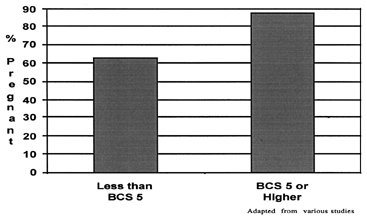
You've reached the Virginia Cooperative Extension Newsletter Archive. These files cover more than ten years of newsletters posted on our old website (through April/May 2009), and are provided for historical purposes only. As such, they may contain out-of-date references and broken links.
To see our latest newsletters and current information, visit our website at http://www.ext.vt.edu/news/.
Newsletter Archive index: http://sites.ext.vt.edu/newsletter-archive/

The Cow-Calf Manager
Livestock Update, November 1997
John B. Hall, Extension Beef Cattle Specialist, Virginia Tech
For the next 12 months, I will be running a monthly column in the Virginia Cattleman's Magazine. I will include the column in the Update so you will be prepared in case you get some questions relating to it. Sometimes I will add related information in the Update for Extension professionals only.
This column is a new monthly series focusing on particular aspects of production and management for the cow-calf operator. Each month, we will cover a single topic in a fairly in-depth manner. The topics will be timed for spring calving herds, but producers with fall calvers will find most of the subjects will apply later.
There are many items of management to a cow-calf operation and it would be difficult to cover them all, so I will focus on some of the more critical management practices. I encourage you to continue to use the Virginia Cooperative Extension Service, the VA Cattlemen's Magazine, other popular press articles and internet pages for additional information.
Body Condition Scoring and Winter Readiness
Body condition scores of 5, 6 or 7 are desirable. However, it is not unusual for good milking cows to be a BCS 3 or 4 at weaning. This year I have seen many BCS 3 cows in pastures in VA due to the drought and limited forage supply. In addition, it is often un-economical for producers to try to maintain cows in BCS 6 or higher during mid to late lactation. In other words, it's all right for a cow to lose some weight when she's nursing a calf. But we need to get her back in shape by the time she calves again.
Cows that calve in BCS 5 or higher are more likely to breed back early (see graph) and have healthier calves. In addition, research has shown that it costs no more and perhaps less to winter a cow in BCS 6 or 7 than to winter a cow in BCS 3 or 4. It takes about 6 to 10% less energy to maintain body weight on a good condition cow than a thin one. The extra insulation provided by the additional fat carried by the high body condition score cows reduces the energy (extra feed) they need to keep warm. Also, it gives them reserves to make it through some of the really cold days.

The best time to get a beef cow back into condition is right after her calf is weaned. Her nutritional requirements are at their lowest, so all extra feed above requirements will go towards increasing her body reserves or BCS. An 1,100 to 1,200 lb cow will have to gain between 75 and 90 lbs to increase one BCS. For example if a cow is a BCS 3 at weaning and we want her to be a BCS 5, she will have to gain 150 to 180 lbs.
It's not unusual for cows to gain 1.5 to 2 lbs. per day, but it still might take 100 days for this cow to gain 2 condition scores. For example, if this BCS 3 cow was fed all she could eat of decent quality fescue hay and 1 lb of ground corn per day plus minerals, she would gain her 2 body condition scores in about 90 to 100 days. Grazing stockpiled fescue is another excellent was to put weight on dry cows.
So, body condition score your cows and adjust your feeding program accordingly. It is helpful if you can sort cows into two BCS groups: thin (> 5) and adequate (5 & up ). This will save on feed and give the thin cows a better chance to get their additional feed without having to fight with larger better conditioned cows. Consult your extension agent or nutritionist for advice on specific feeding programs for your herd with your feeds or pastures.
Next Month: Winter Feeding and Supplements
| Body Condition Scores | |||||||||
|---|---|---|---|---|---|---|---|---|---|
| Reference Point | 1 | 2 | 3 | 4 | 5 | 6 | 7 | 8 | 9 |
| Physically weak | yes | no | no | no | no | no | no | no | no |
| Muscle atrophy | yes | yes | slight | no | no | no | no | no | no |
| Outline of spine visible | yes | yes | yes | slight | no | no | no | no | no |
| Outline of ribs visible | all | all | all | 3-5 | 1-2 | 0 | 0 | 0 | 0 |
| Fat in brisket and flanks | no | no | no | no | no | some | full | full | extreme |
| Outline of hip & pin bones visible | yes | yes | yes | yes | yes | yes | slight | no | no |
| Fat udder & patchy fat around tail head | no | no | no | no | no | no | slight | yes | extreme |
Agents:: We have cards like the above table that Bill McKinnon and Mark Wahlberg designed they are very useful for workshops with producers. Body condition scoring makes a good late fall or early winter workshop. I strongly encourage you to promote BCS as a management tool and assist your producers in learning it.